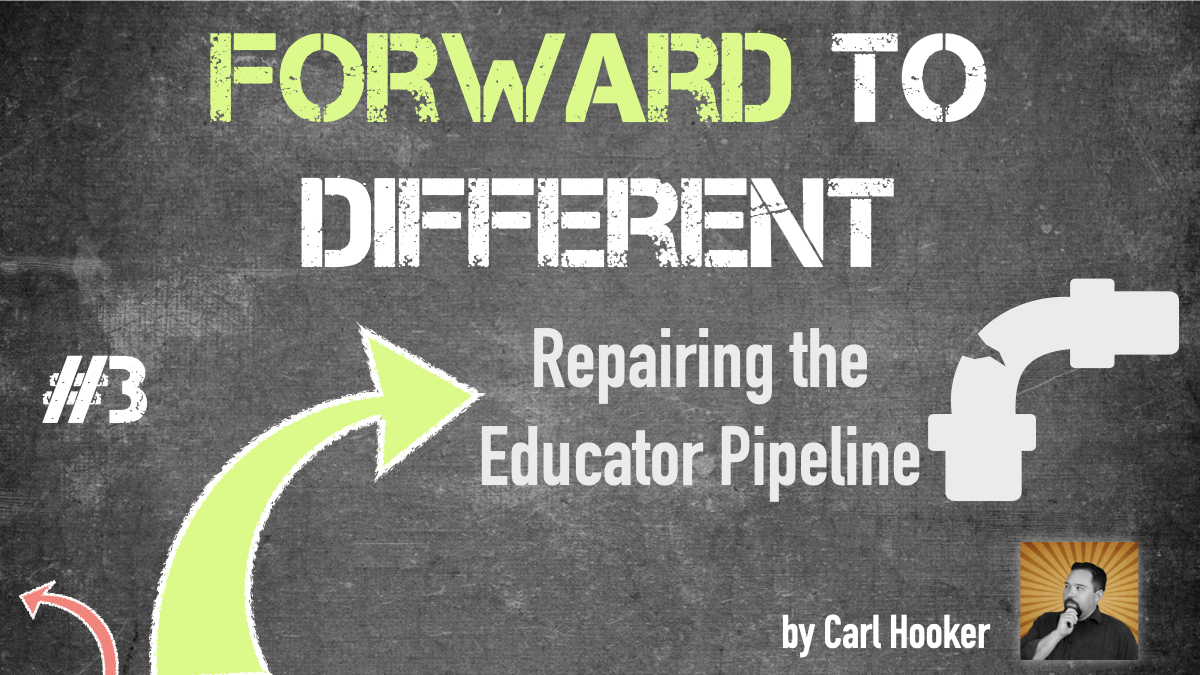Forward to Different – A Blog Series on How School Will Operate After the Big Quit

Teachers and school leaders have been through the wringer during the pandemic. First they were praised for spinning up remote learning in mere days. Then, they were ostracized for not making the remote experience as good as the in-person one. After that, it was COVID protocols, CRT, and fights about what books our kids should read. The cavalcade of over the top school board meetings have become so commonplace, Saturday Night Live did an entire skit about it.
At some point you have to laugh or be forced to cry. On top of all of this mounting pressure is the harsh reality that our teachers are SEVERELY underpaid. This is not anything new, as many states in the union pay less than $60,000 a year which after health care and taxes equates to around $3300 a month to live off of. That’s a little less than $20/hour and that’s just for those that pay $60k a year! There are 34 states that don’t hit that mark in terms of average pay.
We are facing a time famine
Let’s take the money out of the equation for a moment. You can always figure out ways to make more money, but you can’t make more time. We are facing a major TIME FAMINE in our classrooms. More curriculum is packed into our school day as we try and cram instruction in between book battles and school board takeovers. The lack of flexibility and substitute teachers means no extra time for planning engaging lessons or having meaningful professional learning.
In a recent survey published by K12Leaders.com, 67% of respondents said they are “moderately” to “highly” dissatisfied in their current role. Of that group, 88% said they would leave their job with less than 1 month of notice if another job came along. While compensation (74%) and lack of flexibility (70%) came in as high reasoning, the highest was lack of respect (77%). One educator shared the following quote:
“I don’t feel valued in our culture in a general way…. I will always be asked to do more and more and more with less and less. I don’t feel like I have room to advance and I definitely can’t afford to stay in a classroom long term. It gets worse each year. At this rate I will never be able to retire.“
Anonymous educator
“Back to Normal” is not the answer
Schools and communities have been rushing to return things “back to normal” for their students. Removing masks and doing away with social distancing as quickly as possible. Putting technology back in the closet with the belief that was only useful for remote learning and isn’t necessary during the school day. Discarding any flexibility or asynchronous learning options and forcing all students back into synchronous in-person learning. The truth is, this “normal” way of doing school doesn’t serve all children, it only serves a few in the middle.
Students in traditionally underserved communities have struggled with the “Game of School” which is more about making the A and less about actual learning. It’s about getting the best scores on mandated tests and less about longitudinal learning and reflection in a portfolio. We are teaching kids to fill out bubble sheets when we should be filling their minds.
Last year, my oldest child went to middle school completely online. She got most of work done between 10am and noon. Remote learning wasn’t good for many kids, but for some like my daughter, they excelled. Returning to in-person school for this year has led to some struggles that she didn’t encounter before. The school bell schedule is very much gospel in schools. You go to one class for a set amount of time and then onto the next class. The child’s mind and ability to process new information isn’t taken into account when making these schedules.
Time to Eliminate Seat Time Funding
Our school schedule is a symptom of a larger issue in our schools. We are forced by state law to fill out a certain amount of days or minutes with kids physically present in the classroom. This means that it’s more important if your rear end is in a seat than if you are actually learning anything. The devaluing of our learning institutions peaked during the pandemic. Many parent communities were eager to put their students back in school so they could get to work. Schools are large childcare facilities in the minds of these parents, not learning institutions.
To move away from this national belief, school funding shouldn’t be centered around physical presence. Do families still need physical buildings to help with their child’s learning? Absolutely. But do we need to fund schools solely based on seat time and a one-time high stakes test? Absolutely NOT.
Eliminating seat-time funding could open up schools to some creative scheduling and cross-curricular and dare I say, cross-grade level learning. Why do we need to consider this? Our current school system model relies most heavily on ONE major item, we need personnel to make it run.
The Big Quit in Education
The Great Resignation, or “Big Quit”, is happening across multiple industries. Education has been in the cross-hairs of this movement for the past several years, but now the pandemic has amplified it. At recent professional learning conferences I attended numbers were down due to Covid concerns but also a “lack of subs” to cover classrooms. This affected teacher attendance but also administrators who are now covering classrooms on a regular basis. And it’s not just classrooms that are feeling the pinch.
Bus drivers, cafeteria workers, and custodians are in high demand and short supply as well. Schools are so short on bus drivers that the U.S. Department of Education and Department of Transportation essentially waived the need to have a Commercial Driver’s License (CDL) to drive a bus. In addition to these necessary positions to help make the school day run, leadership is also in short supply.
Political pressures and debates on critical race and mask mandates has encouraged many superintendents to seek an early exit from the role. In my home state of Texas alone, there with 60 resignations in the last couple of months. That number is typical of an entire school year and not anywhere near what you would typically see between December and January. On a recent podcast, Doug Roberts, who runs the Superintendent think tank known as the Institute for Education Innovation (IEI), said the numbers were alarming. Not only are we seeing a mass exodus from educational leadership, but in the past “we would see 100-200 applicants for a Superintendent position, now we are seeing 1-3 applicants.”
More people leaving the education profession than those that are joining it means that we will be at a critical breaking point in the next few years. Districts and state governments need to start thinking of creative ways to transform schools in the future. Increasing teaching salaries is a start, like this district in Fayetteville, Arkansas did. But as we discovered on the K12Leaders.com survey, money isn’t the only driving factor.
Forward to Different
There is no magic bullet to fix the disaster that lies ahead for our schools. Some schools in affluent areas may find work arounds with stipends or extra off days, but for the majority of districts, it’s time to think differently. This means we need to stop saying “Back to normal” and starting thinking “Forward to different.” I started to develop a strategy called “Learning Realignment” some months ago, but our educational future may need to be even more extreme.
Over the next few weeks, I will publish a series of different approaches that schools across the country are considering. None of the ideas are 100% fail safe but I applaud districts for taking risks and making some drastic changes to keep their school up and running. Before we tackle these approaches, we must first consider changing some of the things we hold sacred in education.
1. Grade level bands eliminated
One such thing is the “grade level band by age” approach. This video illustrates a point that Sir Ken Robinson famously made in one of his talks. We still educate kids in age batches rather than competency. If we are facing a teacher shortage, this could be on of the first things to go.
2. School schedule less rigid
Another change I’ve already mentioned is the school bell schedule. It perpetuates the factory model of the 1950’s and restricts deeper learning and experiential teaching to some degree. It also requires us to have a certain amount of personnel on hand to teach certain classes. Which leads me to another change that needs to happen.
3. Learning options NOT limited by where you live
Learning is limited by geography. My daughter wants to learn Italian, but her school only offers Spanish. This is for a variety of reasons but the primary two are that there isn’t a teacher qualified to teacher it AND there aren’t enough students interested to justify the expense. She could hop on a bus and head to another middle school that offers it, but why? Did we not just go through almost two years of remote learning? Couldn’t she take a class online with a teacher on the other side of the city? Heck, why couldn’t that teacher even live in a different state or country? We limit learning when we restrict it to only the physical resources available in a geographical area.
4. Curriculum needs an overhaul
The thought of changing WHAT we teach while changing HOW we teach can be terrifying. The truth is, our curriculum is also based on mid-20th century education. Does it make sense to teach kids how to write checks when we live in a world of cryptocurrency and NFTs? The silo-model of curriculum limits our flexibility when it comes to cross-curricular projects and experiences. I wrote about this change in core curriculum in 2017 and think of any time to change our beliefs on curriculum, now is that time.
5. Four-day work week comes to education
Teacher pay is a problem in education, but so is the lack of flexibility. When I taught first grade, bladder control was one of my super powers. Being in charge of young humans for a full day can be taxing physically, mentally and emotionally. Teachers got to experience some rare job flexibility when the pandemic first hit. Being forced to teach online presented many challenges but it also allowed educators to see what a “work from home” environment would be like. With students completing asynchronous tasks, they were able to experience what a lot of the modern working world does. Being able to run errands, go to doctor visits and car appoints without spending time on sub plans has its perks.
Companies across the globe are also starting to see the value in productivity that could be gained from both working from home and a 4-day work week. More and more major companies are starting to make the shift which will have a trickle down effect in education. But rather than wait for the entire world to shift to this model, schools could start now.
A “4/5” schedule (4-day work week for teachers, 5-day learn week for students) could be the answer to our impending educator shortage. I’m working with a school in Florida that is trying to make this happen. Alternating “enrichment days” or creating a space for online learning within the school can help create a level of flexibility and give teachers a true day off (not a planning day or one filled with ‘necessary’ meetings).
We are at the precipice of change
Education has been needing an overhaul for decades. State policies and political pressures have created an environment where those of us in K-12 feel like we can’t innovate and modernize student learning. These four areas of change mentioned above are not the only things we can and should change in education. Assessments, grades, and seat-time all play a large role in everything we do in education and they too will have to be transformed if we are to truly head “forward to different” in our schools.
Recommend0 recommendationsPublished in Leadership Voices






Responses